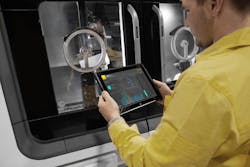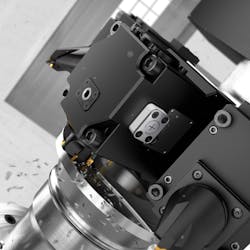Data at the cutting edge: tooling sensors for every application
Sandvik Coromant provides CNC and milling machine tooling for applications worldwide. For technologically advanced machines, its CoroPlus suite of digital products is powered by embedded tools and software for many facets of digital manufacturing, from planning and design to in-machining and machining analysis.
“Our ambition is to collect data close to the cutting edge,” says V. R. Vijay Anand, digital thought leader at Sandvik Coromant. This can provide valuable long-term insights, but, with critical part machining, the real-time view of the process is just as important.
CNC tooling and cutting-edge sensors
“With the Silent Tools Plus, we improve productivity and efficiency. The operator has a near real-time view of the cutting operation,” Anand says. As important as it is to take data from the machine for off-line insights or analytics, especially when machining complex, high-value parts for, say, an aircraft engine, small anomalies that happen in real time need to be measured and detected, he notes. “This will reduce waste big-time and improve productivity,” explains Anand.
It’s not productive to collect data and analyze high-end parts or the machining process as a part is finished. The cutting process is monitored in step, so the machine can take corrective action when needed to prevent component waste (Figure 2). “The closer that we can actually get to the cutting edge and be able to get the data from there and be able to provide insights and actions based on that data, it makes it much more valuable, reduces waste and improves the efficiency,” Anand says.The intelligent tools from Sandvik Coromant have many different types of sensors embedded to provide data close to the cutting edge. The Dampened Silent Tools Plus adapter kit has a vibration sensor, for three-axis vibration measurements and a load sensor for measuring the cutting forces and the bending of the tool. “The Silent Tools can be pretty long, and so a load sensor can help monitor the adaptors bending in two axes—x andy—as well as some enhanced functions of in-cut and roughness,” Anand says.
• the remaining life until service is needed
• the vibration level of the driven tool holder, providing live monitoring of the spindle rpm and direction of rotation
• temperature monitoring withing the driven tool holder.
Tooling-as-a-service
Like many manufacturers, Sandvik Coromant sees potential for as-a-service business models in the future. The company does offer maintenance for its offerings, and its solutions also enable other as-a-service models based on predictive analytics, knowing exactly when a tool change is needed by identifying tool wear and replacing it at the right time. The CoroPlus productivity improvement program (PIP) is service using CoroPlus Machining Insights and Sandvik machining expertise on-site to help improve machining productivity.
Sandvik Coromant would like to expand more as-a-service or outcome-based business models for tooling and other services, and it has taken steps in that direction. A service called Payment Per Part uses the as-a-service business model. The customer is charged according to the volume of components that the customer produces, instead of paying outright for the products and services. “The commercial model is based on outcome or each component being manufactured, rather than selling you 200 inserts or five tools,” Anand says. It is a long-term contractual offer focused on strategic customers with large production volumes, he adds.
More sustainable machines
Operational efficiency is usually the reason for the adoption of digital technology for machine automation, but Anand says data will also be the key to making machining more sustainable. In late 2021, Sandvik Coromant also released its package selector application (PSA), recognizing the global impact of packaging on the environment. The PSA uses data to analyze a 3D CAD model of the Sandvik Coromant product to be packaged, identifies its critical points and uses an artificial-intelligence (AI) algorithm to recommend the smallest amount of packaging possible, reducing packaging waste in its distribution to manufacturers.
5 ways data will help machines waste less
1. Overproduction and defect output are two of the most common contributors to machine’s waste generation.
2. Each individual machine’s data, everything from equipment performance to product quality, is collected via sensors on each machine and is the first method of reducing waste on a large scale.
3. Analyzing individual machine data to optimize machine processes significantly reduces energy use, and small individual machine changes have a huge impact collectively.
4. Analyzing data in real-time can help streamline machine maintenance by identifying problems before they happen, point toward potential energy inefficiencies from machine energy consumption data or eliminate product waste from poor machine performance.
5. Using machine data and lifecycle-assessment (LCA) data promotes a circular manufacturing economy, where waste from one process is used as a resource in another. This closed-loop manufacturing chain or circular manufacturing economy is possible through constant product and process improvements via a robust data strategy.
About the Author
Anna Townshend
Managing Editor
Anna Townshend has been a writer and journalist for 20 years. Previously, she was the editor of Marina Dock Age and International Dredging Review, until she joined Endeavor Business Media in June 2020. She is the managing editor of Control Design and Plant Services.

Leaders relevant to this article:




